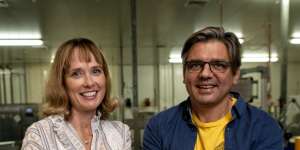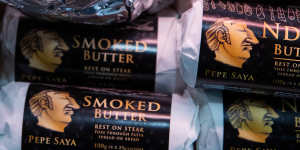“We’re still there today in the same position,selling the butter every weekend,” says Pepe Saya founder and chief butter maker Pierre Issa.

Pepe Saya co-founders and husband-and-wife duo Pierre Issa and Melissa Altman at their Caringbah buttery.Nick Moir
Founded by Issa and his wife Melissa Altman,the business has come a long way since the that kicked off Issa’s butter-making obsession. What began as a Carriageworks stall is now a $12 million company that counts some of Australia’s biggest brands (Qantas,one of its earliest customers) and most respected restaurants (Neil Perry’s Rockpool,Hubert,Aria,Kitchen by Mike) as its advocates.
Its business model has been built upon its prize product:cultured butter,which has a creamier,tangier taste and lower water content than normal butter. Live culture is added to single origin cream and then fermented,which effectively turns into creme fraiche. After a period of maturation,it is batch churned into cultured butter.
Credited as one of the leading pioneers of the artisan cultured butter industry that in the 2010s convinced many high-end restaurants to switch away from French-imported butter,Pepe Saya arguably remains the dominant market leader in the space. Although it does face much fiercer competition in today’s landscape of spreadables (“from hummus to avocado”).

Pepe Saya butter.Edwina Pickles
With the dust settling on the very worst of the pandemic’s disruptions,Issa and Altman are resuming their plans to. Yet they recognise how much they owe their recent success to the pandemic:the size of the business doubled in the three years between 2019 and 2022.
Not that it felt like a window of opportunity at the time. “I remember the date 23rd of March,2020 – that’s like,imprinted in my brain,” says Issa.
“The feel was not that we’re staying open and we’re going to ride through the pandemic. The feel was,we’re closing,what do we need to do to survive this?”
Many food-service and hospitality establishments – Pepe Saya’s main customer base – closed their doors. Distributors were returning pallets upon pallets of butter to Pepe Saya’s manufacturing facilities in south Sydney. “Everyone was in panic mode.”
But the challenge spurred on a wave of innovation and a plan B strategy they never would have considered otherwise. Their online shopfront,which had maybe 20 orders a week,suddenly exploded to as much as 1600 a week,especially in the lead-up to Easter.
Where restaurants and hotels were forced to shut,local cafes boomed. “Bakeries saved us,” says Issa. And then came an idea he describes as a “masterstroke from us as a team”:at a time when radio and TV stations were suddenly left without content,Pepe Saya poured about $1 million into marketing and advertising.
A surge of lockdown-fuelled interest in baking and home cooking led to new products (maple butter,buttercrunch chocolate,passionfruit curd,maple and scone packs,and more) and collaborations with the likes of Sonoma,Gelato Messina,and Butterboy.
Buttering up global customers
With borders open and travel and dining roaring back to life,the cultured butter makers hope their renewed effort (which Issa jokingly describes as “global domination”) to push more deeply into international markets won’t be interrupted again. “We’re actually executing the 2020 plan now,” he says.
Pepe Saya can be found in Texan gourmet grocery store Central Market and in major Asian cities favoured by Western expats,such as Hong Kong and Singapore,as well as Vietnam,Thailand,Korea,Japan,Dubai,and the Maldives.
The plan is to increase its footprint in the US,with Thailand and Vietnam also earmarked for growth,thanks to its increasingly affluent middle class.
Issa is realistic,though. “From our point of view,we only need one or two customers in each country. Think about it – if we have 15 countries we[sold to] and two to three customers[in each],that’s 45 new customers right? It’s a lot for a business our size to handle,so we don’t actually need a lot,” he said.
Pepe Saya is also “in talks” on setting up a facility in England. “It’s something we’re just exploring at the moment ... we’re taking it seriously.”
As it pursues global growth,the company will have to contend with the same inflation and supply shocks that have impacted businesses in every industry. Russia’s war on Ukraine has pushed global fuel and dairy prices,while packaging has increased by more than 10 per cent. All of this forced Pepe Saya to raise the prices of some products by as much as 40 per cent for the first time in five years.
But carefully nurtured relationships with long-term suppliers,six independent dairies across Victoria and the east coast,has ensured steady supply.
While export represents the fastest-growing part of the Pepe Saya business,Issa knows the value in tending to the smallest details for his earliest customers.
“Ever since tastings came back three weeks ago[at Carriageworks],sales went up by 30 per cent.”
The Business Briefing newsletter delivers major stories,exclusive coverage and expert opinion..